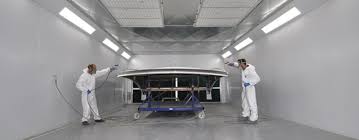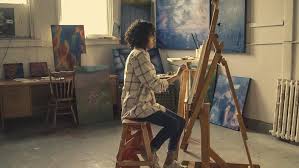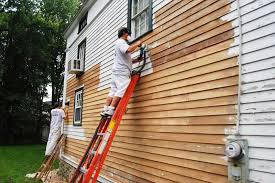Safety Precautions You Should Take When Paint Spraying
You will be glad to hear that paint spraying really is not dangerous work. However, there are hazards, and if you allow the presumed safety of this task to lure you into a false sense of security, you may run into problems.
Today we aim to help you protect yourself against the hazards of painting. Read on for a guide on how to stay safe as you paint.
1. Ventilation:
Finding a ventilated space to paint in is one of the most important precautions that you can take. Keep in mind that the fumes that paints produce aren’t exactly good for you. Many people find them disorienting and even nausea inducing, so be sure that the space you are breathing in has plenty of fresh air. Ventilating a space can be as simple as keeping the doors and windows open.
2. Dress for the Occasion:
In terms of practicality, you are going to want to wear clothes that you don’t mind getting paint on. However, wearing an old shirt is not what we mean when we advise that you dress for the occasion. To stay safe, you are going to want to make sure that you wear good protective eyewear. You will also want to wear a painting mask, gloves, and something that covers your arms and legs. While paint exposure to skin is not the end of the world, it can lead to rashes and irritation. That in mind, it is best avoided when possible.
3. Avoid Heat:
Wet paint and heat don’t go so well together. Avoid painting on surfaces that may be prone to sparks, or heat exposure. Lightbulbs, chords that are in any way damaged, and other volatile materials should not be introduced to paint. Smokers are also going to need to avoid sparking up in the room that they are painting. The cigarette smoke will certainly be detrimental to the ventilation of the office, and the sparks and flame can lead to a fire. And that is pretty much it! Staying safe when you paint isn’t extremely difficult, but it’s definitely important

Improper Ventilation
One of the biggest risks associated with painting involves being in a confined area with little to no airflow. The fumes from the paint can be toxic causing headaches, dizziness, and other harmful side effects. In addition to keeping the doors and windows open, you should also wear a respirator to help filter the toxins out of the air.
Having to Work at Different Heights
When trying to reach ceilings and the upper sections of the walls, you will need to use a ladder or scaffold. When setting up a ladder or scaffold, make sure the legs are securely set on a level surface. If the scaffold has wheels, make sure they are locked before you attempt to climb onto it. Always make sure that you have everything you need prior to getting on the ladder. If you can’t carry the items, climb the ladder and then have someone hand things up to you one at a time.
Slick Surfaces
Spilled paint is common when you are painting a large area. It’s easy to drip paint without knowing it, especially when you are taking the brush or roller from the tray to the surface. Even if the paint is dropped on a tarp, it can make the area extremely slippery. One of the best ways to prevent a slip and fall accident on a slick surface is to wear shoes with non-skid soles. When you get down off of your ladder or before you leave an area, try to wipe up spills or paint drippings you can see. This will prevent you from forgetting they are there and slipping on them when you come back to finish the job.
Uneven Surfaces
Uneven surfaces can cause you to trip and fall. There may be differences between the floors in adjacent rooms which leads to an uneven surface. Setting up a ladder on an uneven surface can cause it to be wobbly and unstable. If you plan on laying down a tarp or plastic before you paint, make sure to smooth it out and lay something heavy along the edges. Make the surface as smooth as possible so there is nothing to trip over or catch the ladder on if you have to move it.

Stay out of heat and away from fire.
Make sure to keep away from heat, sparks and open flame. Don’t smoke. Extinguish all flames, pilot lights and heaters. Turn off stoves, electric tools and appliances, and any other sources of ignition.
Leave the spray paint can whole.
Do not puncture, incinerate or burn aerosol cans. Do not discard cans in a trash compactor. But do recycle them when empty.
Take the following precautions when painting lighting and electrical fixtures:
Read and follow all lighting/fixture manufacturer stated safety precautions.
Ensure corded lamps are unplugged from electricity.
Inspect electrical cords for any damage that could come into contact with unwanted paint or overspray.
Do NOT paint wiring.
Do NOT paint light bulbs.
Do NOT paint damaged cords which may have exposed wiring.
Do NOT paint parts of fixtures that get excessively hot, unless using a High Heat paint specified for that purpose.
Take the following precautions when painting objects in contact with open flame (candle holders, fire pits, etc.)
Do NOT paint in the vicinity of an open flame.
Do NOT paint any surface that will be in contact with an open flame, especially the insides.
Do NOT leave open flames unattended in any situation.
If using High Heat paint, read back of product label to ensure expected heat is within the recommended temperature ranges of the paint.

Painting safety
A fresh coat of paint is an easy way to spruce up your home’s exterior or your favorite room in the house. But when painting indoors, you should follow certain measures and painting safety precautions to protect yourself and your family.
Prepare for Safe Painting
Many interior paint, stain and stripper fumes aren’t just harmful to inhale, they can also be extremely flammable. You should always keep the area well ventilated by opening doors and windows. Use an exhaust fan to remove fumes from your workspace. Never paint or use solvents, strippers, stain, caulking or clean-up supplies near an open flame like the pilot light of a furnace or water heater. And never smoke while painting!
Safety Alerts!
- When working with solvent-based materials, it’s best to wear a respirator to prevent inhaling harmful fumes. When sanding, you should wear a dust mask to prevent particles from entering the lungs. If possible, use a power sander with a sawdust collection bag.
- If you can avoid it, don’t sleep in a freshly painted room for at least two days.
- Use canvas drop cloths instead of plastic on the floor. Cloth stays in place better and is less slippery than the alternative.
Be Safe Around Electrical Outlets
Be sure to practice painting safety when painting or working near electrical outlets, cover all exposed outlets with painter’s tape. If you need to remove outlet or switch covers to paint, turn off the power to the room before you start.
Clean Up and Dispose of Paint Properly
Many people don’t know that leftover latex paint has to dry completely before you can dispose of it. Even if you have used all the paint from a can, allow the empty container to dry with the lid off before discarding. If there is less than a quarter of the can left, you can let the paint dry by leaving it in a well-ventilated area until it hardens, stirring it once every few days. When leaving paint out to dry, be sure to keep it in an area that’s away from children, pets and open flames.